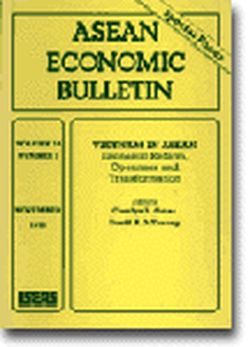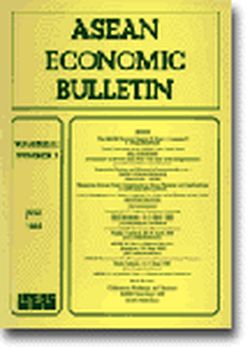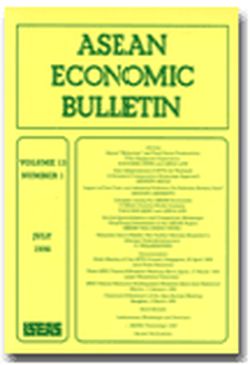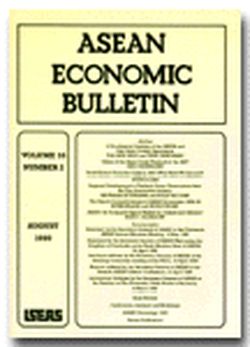ASEAN Economic Bulletin Vol. 13/2 (Nov 1996). Special Focus on "Vietnam in ASEAN: Economic Reform, Openness and Transformation"

Date of publication:
November 1996
Publisher:
Institute of Southeast Asian Studies
Number of pages:
123
Code:
AE13/2
About the publication
ASEAN Economic Bulletin Vol. 13/2 (Nov 96). Special Focus on "Vietnam in ASEAN: Economic Reform, Openness and Transformation", edited by Carolyn L Gates and David H D Truong
Contents
-
Preliminary pages
- ARTICLES:
-
Vietnam in ASEAN -- Economic Reform, Openness and Transformation: An Overview
-
Economic Reform and Openness in Vietnam: Micro-economic Response and Transformation see abstractThe transformation that Vietnam has undergone during the decade between 1985 and 1995 is truly remarkable. For the ten years ending in 1995, Vietnamâs average gross domestic product (GDP) growth rate was 6.4 per cent, the best performance among low-income economies. As a result of this rapid growth, the decline in poverty incidence is estimated to be from about 75 per cent in 1985 to about 50 per cent today. Two factors were particularly important for Vietnamâs quick adjustment: improved macroeconomic management and growing openness. While Vietnamâs economic performance has been good, it remains a poor country facing significant challenges. This article examines the main challenges that remain, including inflation control, further trade liberalization, and state enterprise reform and privatization. Vietnamâs entry into ASEAN in 1995 increased the likelihood that the reform programme will remain on track.
-
Vietnam's Foreign Trade in the Context of ASEAN and the Asia-Pacific Region: A Gravity Approach see abstractThe aim of this article is to examine the major factors influencing Vietnamâs trade with the Association of Southeast Asian Nations (ASEAN) and other Asia-Pacific countries. To assess these trading relationships, we estimate a gravity model incorporating Vietnam and 17 Asia-Pacific Economic Cooperation (APEC) countries. Our results show that Vietnam has turned from being an âunder-performerâ in terms of intraregional trade in 1989 to being at least âaverageâ in 1994. This indicates that the determinants of Vietnam/Asia-Pacific trade are now the same factors which are important in determining the intraregional trade levels of other Asia-Pacific countries, namely GNP, GNP per capita, and geographical distance. In other words, artificial barriers to trade, which seriously hindered Vietnamâs trade before 1990, appear at present to affect it no more than they do other Asia-Pacific countries. Nevertheless, there is room for growth in trade between Vietnam and some Asia-Pacific countries.
-
Vietnam in ASEAN: Trade, Investment and Other Economic Effects see abstractThe relatively undeveloped institutional structure and infrastructure in Vietnam represents both a challenge and deterrent to foreign investors both from within and outside the Association of Southeast Asian Nations (ASEAN). In the short and medium run, Vietnam stands to gain from membership in ASEAN as it can tap into ASEANâs technology, capital and intermediate inputs since the ASEAN member countriesâ economic structure is âcloserâ to that of Vietnam compared to other developed countries and thus more suitable to the needs of Vietnam. In the longer run, the ASEAN-6 countries stand to gain from Vietnam with the enhancement of the latterâs market and purchasing power. Trade diversion as a result of Vietnamâs membership in ASEAN is minimal and thus the welfare of both ASEAN and Vietnam can be expected to increase with Vietnamâs membership in ASEAN.
-
Economic Reform, Openness, and Vietnam's Entry into ASEAN see abstractEconomic stabilization and market liberalization reforms, which were introduced in Vietnam in the late 1980s, have stimulated a variety of micro-economic responses. To examine this process, a survey of 91 Vietnamese state and private industrial enterprises and additional case studies of selected enterprises were carried out in Hanoi and Ho Chi Minh City. Data collected and analysed from these sources provide empirical evidence on shifting enterprise behaviour and performance and other micro-economic effects of the reform process. This article1 presents, first, general observations on micro-economic transformation in Vietnam and second, results of empirical analysis of selected variables that shed light on enterprise response to reform.
-
Economic Growth and Transformation: Vietnam's Challenge of Human Resource Development see abstractNational economic growth and development depend upon the interaction of a set of exogenous and endogenous variables. Among the endogenous factors are human resource development (HRD) and what has been called âsocial capabilitiesâ. The prospects for human resource development in Vietnam are relatively bright. The countryâs workforce has the capacity to augment its current skill level through education and training, as revealed by the countryâs relatively strong human development index (HDI). Continued improvement in skills and productivity requires the execution of effective public policies, which brings up the question of whether Vietnam has the âsocial capabilitiesâ to do so. On this score, Vietnam faces a challenge. Meeting this challenge while promoting rapid economic growth requires additional public policies to provide all Vietnamese opportunities to gain access to skills and income-generating employment.
-
A Model Design for Vietnam as an Open Economy in Transition see abstractVietnamâs recent history of reforms and its unique features suggest a design for a global dynamic equilibrium model to study its economic linkages with the rest of the world. The countryâs mix of developing/transitional economy characteristics, and decision to adopt outward-oriented reform policies make it a good choice for a pilot study in model design with possible application to other developing economies in transition. The speed and smoothness of its path towards developed-economy status will be policy-determined, and attention must be paid to how these should or should not be interpreted within a model design exercise. Automatic application of the theoretical paradigms and standard equations appropriate for a developed country macroeconomic model to a developing country in transition from a centrally planned to a market-oriented system will likely result in model mis-specification. The technical modelling constraints, and the constraints of reality force such an examination to consider the economyâs steady-state condition, perhaps 50 to 100 years away. As a modelling vehicle, the authors suggest a dynamic equilibrium model framework which includes several key model features in as flexible and evolving a structure as possible: (1) a global modelling context; (2) forward-looking expectations mechanisms; (3) time-varying endogenous coefficients, and (4) time-dependent relationships which guarantee necessary long-run stability in the steady state.
-
DOCUMENTATION: Basic Framework of ASEAN-Mekong Basin Development Cooperation Kuala Lumpur, 17 June 1996
-
DOCUMENTATION: Joint Communique of the Twenty-Ninth ASEAN Ministerial Meeting Jakarta, Indonesia, 20-21 July 1996
-
DOCUMENTATION: Speech of H.E. Dato Ajit Singh, Secretary-General of ASEAN at the ASEAN-CCI Meeting, Hochiminh City, 21 August 1996
-
BOOK REVIEW: Macroeconomic Management in Southeast Asia's Transitional Economies. Edited by M.F. Montes, R.A. Reyes, and S. Tambunlertchai (reviewed by Lu Ding)
-
Recent Publications






